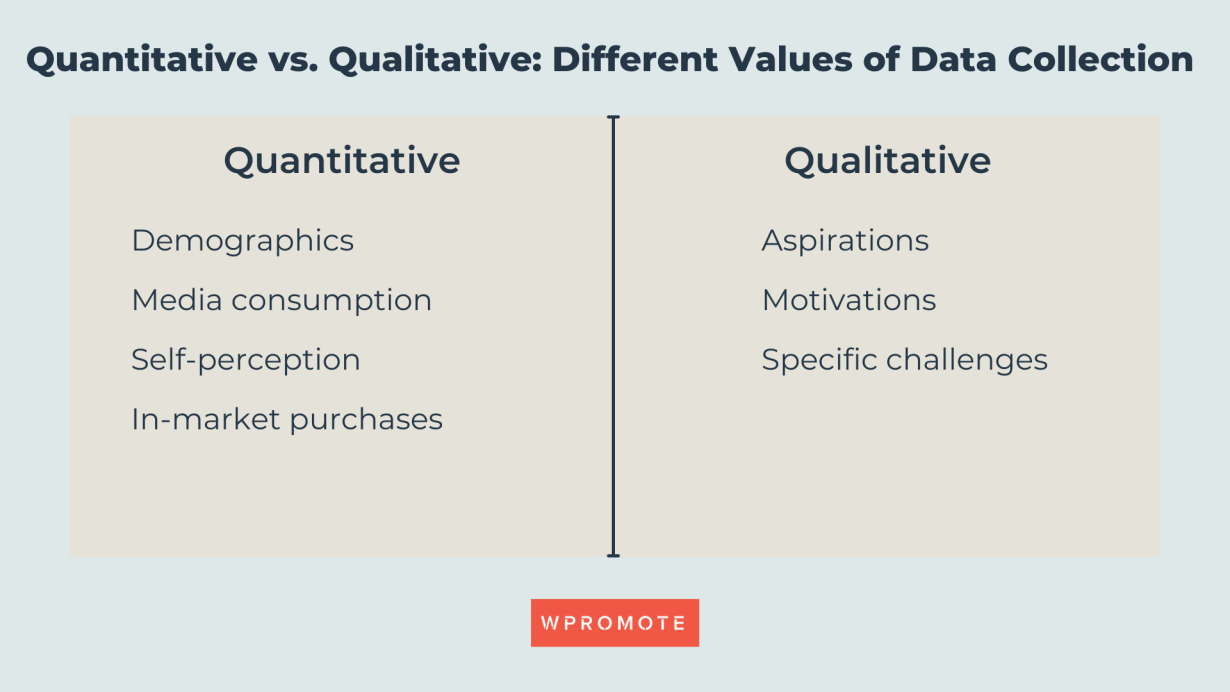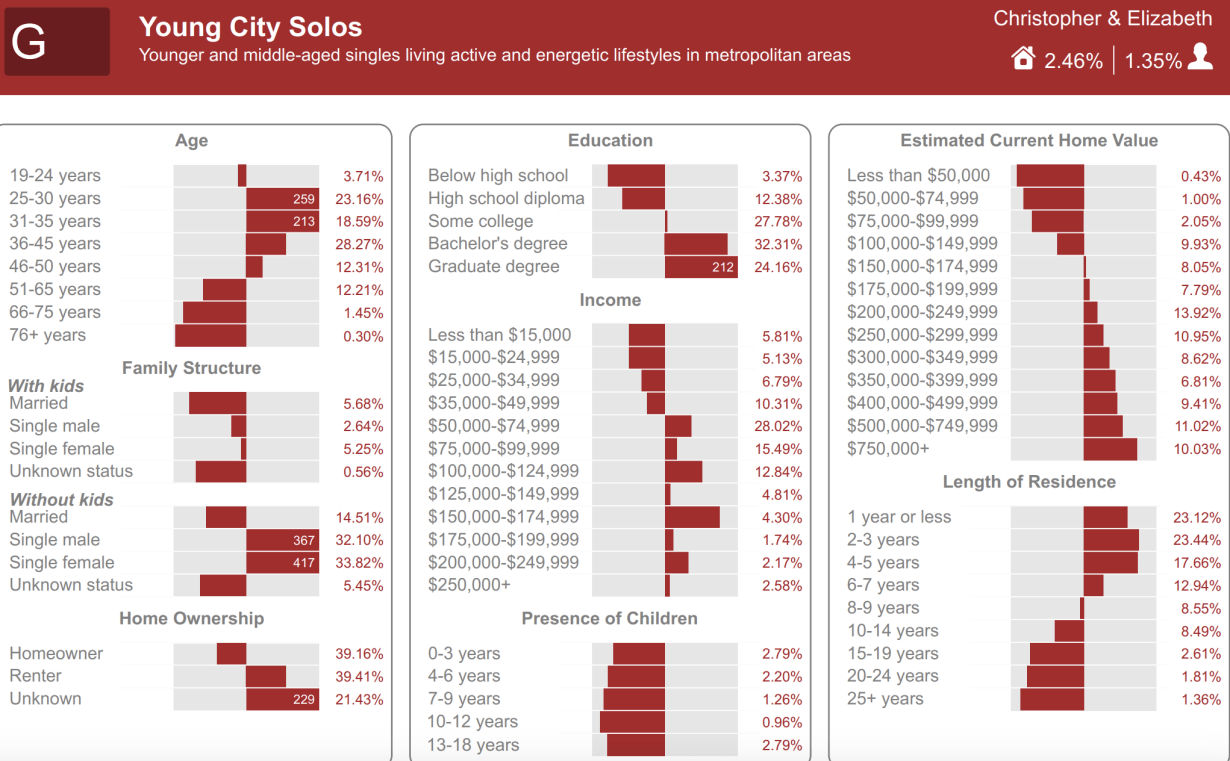Marketers now have access to a treasure trove of data and signals about audiences, but that hasn’t always translated to a better understanding of the actual people behind the numbers.
When marketers get too caught up thinking about people as just “users” or “segments” that can impact performance metrics, they’re left with a one-dimensional view of their customers and prospects. And that’s not enough if you want your brand to win.
When marketers open up their research to dig deeper into the lifestyles, behaviors, self-perceptions, and beliefs of the people they’re marketing to, they get more insight into the true motivations behind interactions with brands and purchase decisions that drive deeper connections and stronger performance over time.
A better approach to audience insights is essential to both brand and business success. But how do we get there?
Building better audience insights: the fine balance between qualitative and quantitative data
There are two main approaches that marketers take to find out more about their audience: quantitative and qualitative. And each brings a different kind of value to the table.
Marketers use quantitative data by pooling together a large number of attributes to learn about their target audiences and get insight into their behaviors, preferences, and purchasing patterns. They can leverage those data sets to make more informed decisions based on statistical analysis and measurable metrics. In general, that kind of data is easy to collect, so many brands rely almost exclusively on it to draw conclusions about their audiences.
Qualitative data, on the other hand, can reveal motivations, attitudes, beliefs, and preferences. Findings are descriptive and non-numerical, and collection requires a bit more effort, usually taking the form of surveys, polls, interviews, focus groups, or experiments that involve a control group and an experimental group.
Because qualitative data is often self-declared, it’s subject to psychological and social factors that can distort results, like when survey-takers try to suss out (consciously or unconsciously) and deliver the answer the surveyor is looking for. There can also be major differences between what people say they do and what they actually do. 46% of people, for example, who say they believe in sustainability also point to Amazon as their favorite retailer, according to GWI.
That’s why it’s critical to use both data types to get a more complete picture of your audiences.

If your marketing decisions are only informed by quantitative data alone, that’s not good enough. Qualitative data will enrich those data sets with essential context, and finding the right balance should be the standard operating procedure for every brand.
Use qualitative data to probe deeper into someone’s unique feelings or emotions about a particular brand, product, or service so you can better understand the motivations behind particular behaviors observable in your quantitative data. The combination of the two will get you closer to the “why” behind a specific question. Remember: your overall goal is to develop a robust, multidimensional understanding of your audience as people.
Testing the limits of marketing personas: common mistakes
Most brands take a persona-based approach to audiences, building fictional profiles (often featuring a quasi-clever alliterative name, because marketers like to have fun too) to stand in for a particular group of similar people. These personas are usually based on conclusions drawn from some mix of third-party research, quantitative data, and (hopefully) qualitative insights.
The goal of these personas, of course, is to articulate key characteristics, behaviors, goals, and needs of specific segments of the brand’s target audience. But they come with some known pitfalls and problems; for one, they are often rarely revised, so they represent a moment in time but are used as widely definitive over periods of months or years. They also tend to be overly broad and lead to a flattening of broad groups of consumers.
Here’s an example of a common persona: the Young City Solos profile is based almost entirely on qualitative data about an extremely wide group of consumers, defined as younger and middle-aged singles living active and energetic lifestyles in metropolitan areas. There are wide disparities in education level, income, home value, and more. You would be hard-pressed to generate useful, specific insights that will help you build better marketing campaigns with such a broad single “persona” standing in for a diverse group.

Source: Research Wizard
But there is a bigger problem; the methodology behind most persona building can actually reinforce stereotypes and assumptions about different groups that are then reflected in and amplified across campaigns and marketing assets of all kinds.
By doubling down on broad, static conclusions about diverse, dynamic groups of real people, personas can actually produce the kinds of problems they were built to counteract. Your campaigns may feel distinctly impersonal and unspecific, or even downright offensive to the groups you want to reach if they perpetuate problematic stereotypes.
Personas can be an important and useful part of your toolset, but your approach to persona-building needs to be revamped for a modern version of marketing that is based on an audience-first approach vs. a media-first strategy.
Understanding your audience in three dimensions: first-party data enrichment
Finding a workable solution that drives useful audience insights but doesn’t take an overwhelming amount of time and effort starts with first-party data enrichment.
Your first-party data is one of your brand’s most valuable assets, but its value is really determined by the myriad ways you put it to work. Enrichment augments your owned data with additional information from other sources to produce a more accurate, nuanced picture.
To unlock that capability, you need to manage your data. Many brands use customer relationship management (CRM) software or customer data platforms (CDPs) to aggregate and organize data sources, which is especially important if your data is used by different software, systems, and teams. The goal is to build a single source of truth so everyone can make decisions based on the same numbers and can trust that the data is accurate.
Once you have your first-party data organized, you can upload it to a third-party platform partner that specializes in data enrichment to augment your own data with behavioral, demographic, and geographic information, for example.
Then it’s time to analyze that enriched data to learn more about your customer’s behavior, preferences, and needs. You can leverage those learnings to identify patterns, discover trends, and find new opportunities to connect with those audiences.
Remember that all of that knowledge isn’t static; the process of audience discovery needs to be continuous because people change all the time.
The pandemic is a perfect example; the universality of that sudden shift in behavior forced many marketers to challenge their assumptions about audiences. Older people started using delivery apps, young adults moved out of urban areas, and moms started picking up gaming. Brands needed to adapt accordingly.
These kinds of behavioral changes don’t just happen in tandem with crazy, world-shaking events. In fact, they’re happening all the time. But if your process leverages only limited sets of data and methods of collecting information, it won’t be built to identify or evolve based on changes in behavior. A better version of a marketing persona needs to account for unique, multi-hyphenate, or malleable traits and how people change over time.
Connecting across teams: unsilo audience insights across the funnel
These enriched insights can also help breach silos between brand and performance teams by helping them get on the same page and aligned around their audiences, even if they use that information in different ways. Brand teams traditionally leverage broad personas that represent an aspirational view of an ideal consumer, while performance teams focus on a view of the audience based on quantitative data they can use for targeting in campaigns.
But a unified view of your brand’s audience across the full funnel will help ensure a customer’s experience with your brand and their journey from discovery to purchase are as seamless as possible because everyone is working from the same playbook and toward the same goals.
Building rich, dynamic personas that give both brand and performance teams what they need to succeed takes work.
There’s no one action or tool that will give you everything you need. But once it’s in place, you’ll quickly reap the benefits.
There are some guidelines that will help you make sure the new persona you’re building is as useful as possible for your teams:
- Prioritize psychographics over demographics
- Identify both motivations and barriers to purchase
- Dig into what drives a person to opt-in/submit info for a lead
- Learn the types of triggers and influences get your audience into the buying mindset
- Look for patterns in lifestyle that correlate with current purchasing behaviors
- Find out where they spend their time online and offline
- Ask questions that focus on the consumer’s passions when you’re collecting qualitative data
The biggest thing to keep in mind? Always remember the why. It’s not enough to just know your audience uses TikTok for a certain number of minutes every day. You need to dig into why they use TikTok and what kind of mindset they’re in when they’re there. What are they looking for? What gets them to keep scrolling?







Responses